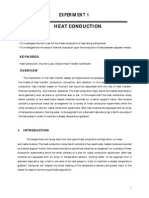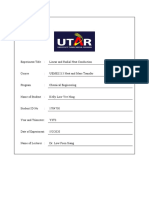Experiment 1 Linear
Uploaded by
DeniseLimExperiment 1 Linear
Uploaded by
DeniseLimUniversiti Tunku Abdul Rahman
Faculty Lee Kong Chian Faculty of Engineering and
Science
Department: Department of Mechanical and Material
Engineering
Unit Code and Name UEME 3213 Heat and Mass Transfer
Experiment No.: 1/2
Title of Experiment: Linear and Radial Heat Conduction Experiment
Laboratory Room No. and Name: KB731
Experiment Duration (hour) 3 hours
Number of Student per Group 5 students x 4 groups
Number of Student per Session 20
Objective:
In this experiment, students shall learn how to examine the temperature profile and determine
rate of heat transfer for both linear and radial conduction.
Introduction:
Thermal conduction is the mode of heat transfer, which occurs in a material by virtue of a
temperature gradient. In the laboratory, a single dimensional approach is required to
demonstrate the basic law that relates rate of heat flow to temperature gradient and area.
Theory
Linear Conduction Heat Transfer (Homogeneous bar)
Fouriers Law states that:
dT
Q kA
dx
where, Q = heat flow rate, [W]
W
k = thermal conductivity of the material,
k m
A = cross-sectional area of the conduction, [m2]
dT = changes of temperature between two points, [k]
dx = changes of displacement between two points, [m]
1 Latest updated: 15th Dec 2016 (DLMSA)
Radial Conduction Heat Transfer (Cylindrical)
When the inner and outer surfaces of a thick walled cylinder are each at a uniform
temperature, heat flows radially through the cylinder wall. From continuity considerations the
radial heat flow through successive layers in the wall must be constant if the flow is steady
but since area of successive layers increases with radius, the temperature gradient must
decrease with radius.
The amount of heat (Q), which is conducted across the cylinder wall per unit time, is:
2Lk (Ti To )
Q
R
ln o
Ri
where, Q = heat flow rate, [W]
W
k = thermal conductivity of the material,
k m
L = thickness of the conduction, [m]
Ti = inner section temperature, [K]
To = outer section temperature, [K]
Ro = outer radius, [m]
Ri = inner radius, [m]
Description:
Unit Assembly
The equipment comprises two heat-conducting specimens, a multi-section bar for the
examination of linear conduction and a metal disc for radial conduction. A control panel
supplies electrical power to the heaters and shows readings for all relevant measurements.
A small flow of cooling water provides a heat sink at the end of the conducting path
in each specimen.
2 Latest updated: 15th Dec 2016 (DLMSA)
1
7
2
3 8
4
9
5
Figure 1: Unit Assembly for Heat Conduction Study Bench (Model: HE 105)
1. Control Panel 6. Thermocouple Connectors
2. Heater Power Indicator 7. Thermocouples
3. Heater Power Regulator 8. Radial Module
4. Temperature Indicator 9. Linear Module
5. Temperature Selector
Specifications
Linear Module
Consists of the following sections:
i) Heater Section
Material : Brass
Diameter : 25 mm
ii) Cooler Section
Material : Brass
Diameter : 25 mm
iii) Interchangeable Test Section - Insulated Brass Test Section with
Temperature Sensors Array (Diameter = 25mm, Length = 30 mm)
Radial Module
Material : Brass
Diameter : 110 mm
Thickness : 3 mm
3 Latest updated: 15th Dec 2016 (DLMSA)
Instrumentations
Linear module consists of a maximum of 9 type K thermocouple
temperature sensors at 10 mm interval. For radial module, 6 type K
thermocouple temperature sensors at 10 mm interval along the radius are
installed.
Each test modules are installed with a 100 Watt heater.
Equipment and Materials
Quantity estimation
Item Description *Item category (e.g. per set/group of
student)
Control Panel E 1
Thermocouple Connectors E 1
Thermocouples E 1
Radial Module E 1
Linear Module E 1
Water supply W 1
*Item category
SP Sample or specimen
C Consumable
CH Chemical
W Labware, glassware, tool, and
components
E Equipment
S Software
Experimental Procedures:
Linear Conduction Heat Transfer
1. Make sure that the main switch initially off. Then Insert a brass conductor
(25mm diameter) section intermediate section into the linear module and
clamp together.
2. Install the temperature sensors T1 until T9 to the test module and connect
the sensor leads to the panel.
3. Connect the heater supply lead for the linear conduction module to the
power supply socket on the control panel.
4. Turn on the water supply and ensure that water is flowing from the free
end of the water pipe to drain. This should be checked at intervals.
5. Turn the heater power control knob control panel to the fully anticlockwise
position.
6. Switch on the power supply and main switch; the digital readouts will be
illuminated.
4 Latest updated: 15th Dec 2016 (DLMSA)
7. Switch on the heater and turn the heater power control to 20 Watts and
allow sufficient time to achieve steady state condition before recording the
temperature at all temperature points as well as the input power reading on
the wattmeter (Q). This procedure can be repeated for other input power
between 0 to 20 watts. After each change, sufficient time must be allowed
to achieve steady state conditions again.
8. Plot of the temperature, T versus distance, x. Calculate the thermal
conductivity of the test section.
Note:
i) When assembling the sample between the heater and the cooler
sections, care should be taken to match the shallow shoulders in the
housings.
ii) Ensure that the temperature measurement points are aligned along the
longitudinal axis of the unit.
iii) The insulation material of the test modules can withstand up to 100 C
only. Reduce the heater power immediately if the temperature nearest
to the heater is too high.
Results:
Heater Power, Q T1 T2 T3 T4 T5 T6 T7 T8 T9
(Watts) (C) (C) (C) (C) (C) (C) (C) (C) (C)
5
10
15
20
Distance from
Heater End, x (m)
5 Latest updated: 15th Dec 2016 (DLMSA)
Radial Heat Transfer
1. Make sure that the main switch initially off.
2. Install the temperature sensors (T1 until T7) to the radial test module and
connect the sensor leads to the panel.
3. Connect the heater supply lead for the radial conduction module into the
power supply socket on the control panel.
4. Turn on the water supply and ensure that water is flowing from the free
end of the water pipe to drain. This should be checked at intervals.
5. Turn the heater power control knob control panel to the fully anticlockwise
position.
6. Switch on the power supply and main switch; the digital readouts will be
illuminated.
7. Switch on the heater and turn the heater power control to 20 Watts and
allow sufficient time to achieve steady state condition before recording the
temperature at all six sensor points as well as the input power reading on
the wattmeter (Q). This procedure can be repeated for other input power
between 0 to 20 watts. After each change, sufficient time must be allowed
to achieve steady state conditions again.
8. Plot of the temperature, T versus distance, r. Calculate the thermal
conductivity of the test section.
Note:
The insulation material of the test modules can withstand up to 100 C
only. Reduce the heater power immediately if the temperature nearest to
the heater is too high.
Results:
Heater Power, Q T1 T2 T3 T4 T5 T6
(Watts) (C) (C) (C) (C) (C) (C)
5
10
15
20
Distance from Heater
End, Ri or Ro (m)
6 Latest updated: 15th Dec 2016 (DLMSA)
You might also like
- SSG (747-8) General Pre-Flight Checklist From Cold & Dark V1.2No ratings yetSSG (747-8) General Pre-Flight Checklist From Cold & Dark V1.210 pages
- Experiment #1: Fourier'S Law: Conduction Along A Simple Bar100% (2)Experiment #1: Fourier'S Law: Conduction Along A Simple Bar6 pages
- Objectives:: Experiment No.3 Radial ConductionNo ratings yetObjectives:: Experiment No.3 Radial Conduction5 pages
- Experiment 14 - Heat Conduction Study BenchNo ratings yetExperiment 14 - Heat Conduction Study Bench11 pages
- Experiment 1.thermal Conductivity of Metal Rod-3No ratings yetExperiment 1.thermal Conductivity of Metal Rod-36 pages
- Thermal Engg. Practical PR 1 To PR 5 PDFNo ratings yetThermal Engg. Practical PR 1 To PR 5 PDF18 pages
- Thermal Conductivity Apparatus: (Two Slab Guarded Hot Plate Method)No ratings yetThermal Conductivity Apparatus: (Two Slab Guarded Hot Plate Method)8 pages
- Thermal Conductivity of Liquids: Ka X T TNo ratings yetThermal Conductivity of Liquids: Ka X T T34 pages
- Laboratory Manual: Heat Transfer ME-316-ENo ratings yetLaboratory Manual: Heat Transfer ME-316-E27 pages
- Thermal Conductivity of Metal Rod: Instruction ManualNo ratings yetThermal Conductivity of Metal Rod: Instruction Manual8 pages
- Experiment No.01 Title: Thermal Conductivity of Insulating PowderNo ratings yetExperiment No.01 Title: Thermal Conductivity of Insulating Powder6 pages
- Experiment Fourier'S Law: Conduction Along A Simple BarNo ratings yetExperiment Fourier'S Law: Conduction Along A Simple Bar11 pages
- 1 Thermal Conductivity of Insulating PowderNo ratings yet1 Thermal Conductivity of Insulating Powder6 pages
- Quantity Estimation 1 Unit 1 Unit 1 Set 1 Set: (E.g. Per Set/group of Student)No ratings yetQuantity Estimation 1 Unit 1 Unit 1 Set 1 Set: (E.g. Per Set/group of Student)2 pages
- UEME 3213 Heat and Mass Transfer AssignmentNo ratings yetUEME 3213 Heat and Mass Transfer Assignment2 pages
- Tutorial No.1: Network Analysis and Theorems: Ueea1253 Circuits, Signals and SystemsNo ratings yetTutorial No.1: Network Analysis and Theorems: Ueea1253 Circuits, Signals and Systems3 pages
- UEME 2123 Fluid Mechanics 1 - Chapter 1 PDFNo ratings yetUEME 2123 Fluid Mechanics 1 - Chapter 1 PDF56 pages
- AVPT-CF16-01-Rev.01-P100263339A000263339No ratings yetAVPT-CF16-01-Rev.01-P100263339A0002633391 page
- Mentor Graphics Corporation, Using DesignChecker With SystemVerilog-VHDL Assistant, Release v2018.2No ratings yetMentor Graphics Corporation, Using DesignChecker With SystemVerilog-VHDL Assistant, Release v2018.258 pages
- Bekic - Brodolomi Na Rtu Uljeva Kod Ližnjana 2013 - SH3No ratings yetBekic - Brodolomi Na Rtu Uljeva Kod Ližnjana 2013 - SH35 pages
- The Fuselage Cross Section and Nose Is Derived From That of TheNo ratings yetThe Fuselage Cross Section and Nose Is Derived From That of The6 pages
- 2-Mathematical Modeling and Simulation of Hydrotreating Reactors Cocurrent Versus Countercurrent Operations - Art5No ratings yet2-Mathematical Modeling and Simulation of Hydrotreating Reactors Cocurrent Versus Countercurrent Operations - Art514 pages
- FINAL Exam Schedule For 1st Semester SY 2019-202075% (8)FINAL Exam Schedule For 1st Semester SY 2019-202054 pages
- Objectives of Indian Association For Medical InformaticsNo ratings yetObjectives of Indian Association For Medical Informatics2 pages
- It Ips 3110 Iu 2gc 4 Poe Datasheet - SWITCH ETHERNET POE INDUSTRIALNo ratings yetIt Ips 3110 Iu 2gc 4 Poe Datasheet - SWITCH ETHERNET POE INDUSTRIAL2 pages
- For HYUNDAI GETZ ELANTRA MATRIX SANTA FE TUCSON TRAJET COUPE IGNITION SWITCH EbayNo ratings yetFor HYUNDAI GETZ ELANTRA MATRIX SANTA FE TUCSON TRAJET COUPE IGNITION SWITCH Ebay1 page
- Plant Production Management System For PFAL (Plant Factory With Artificial Lighting) Beijing, China May 9-10, 2015 Association For Vertical FarmingNo ratings yetPlant Production Management System For PFAL (Plant Factory With Artificial Lighting) Beijing, China May 9-10, 2015 Association For Vertical Farming34 pages
- SSG (747-8) General Pre-Flight Checklist From Cold & Dark V1.2SSG (747-8) General Pre-Flight Checklist From Cold & Dark V1.2
- Experiment #1: Fourier'S Law: Conduction Along A Simple BarExperiment #1: Fourier'S Law: Conduction Along A Simple Bar
- Thermal Conductivity Apparatus: (Two Slab Guarded Hot Plate Method)Thermal Conductivity Apparatus: (Two Slab Guarded Hot Plate Method)
- Thermal Conductivity of Metal Rod: Instruction ManualThermal Conductivity of Metal Rod: Instruction Manual
- Experiment No.01 Title: Thermal Conductivity of Insulating PowderExperiment No.01 Title: Thermal Conductivity of Insulating Powder
- Experiment Fourier'S Law: Conduction Along A Simple BarExperiment Fourier'S Law: Conduction Along A Simple Bar
- Quantity Estimation 1 Unit 1 Unit 1 Set 1 Set: (E.g. Per Set/group of Student)Quantity Estimation 1 Unit 1 Unit 1 Set 1 Set: (E.g. Per Set/group of Student)
- Tutorial No.1: Network Analysis and Theorems: Ueea1253 Circuits, Signals and SystemsTutorial No.1: Network Analysis and Theorems: Ueea1253 Circuits, Signals and Systems
- Mentor Graphics Corporation, Using DesignChecker With SystemVerilog-VHDL Assistant, Release v2018.2Mentor Graphics Corporation, Using DesignChecker With SystemVerilog-VHDL Assistant, Release v2018.2
- Bekic - Brodolomi Na Rtu Uljeva Kod Ližnjana 2013 - SH3Bekic - Brodolomi Na Rtu Uljeva Kod Ližnjana 2013 - SH3
- The Fuselage Cross Section and Nose Is Derived From That of TheThe Fuselage Cross Section and Nose Is Derived From That of The
- 2-Mathematical Modeling and Simulation of Hydrotreating Reactors Cocurrent Versus Countercurrent Operations - Art52-Mathematical Modeling and Simulation of Hydrotreating Reactors Cocurrent Versus Countercurrent Operations - Art5
- Objectives of Indian Association For Medical InformaticsObjectives of Indian Association For Medical Informatics
- It Ips 3110 Iu 2gc 4 Poe Datasheet - SWITCH ETHERNET POE INDUSTRIALIt Ips 3110 Iu 2gc 4 Poe Datasheet - SWITCH ETHERNET POE INDUSTRIAL
- For HYUNDAI GETZ ELANTRA MATRIX SANTA FE TUCSON TRAJET COUPE IGNITION SWITCH EbayFor HYUNDAI GETZ ELANTRA MATRIX SANTA FE TUCSON TRAJET COUPE IGNITION SWITCH Ebay
- Plant Production Management System For PFAL (Plant Factory With Artificial Lighting) Beijing, China May 9-10, 2015 Association For Vertical FarmingPlant Production Management System For PFAL (Plant Factory With Artificial Lighting) Beijing, China May 9-10, 2015 Association For Vertical Farming






























































































